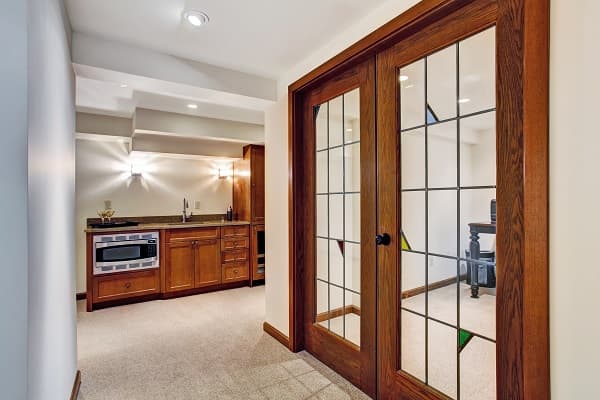A Solid Base: Everything About Concrete Foundations
By Editorial Team
Updated on August 2, 2024

A sturdy house starts with a solid, concrete foundation. To build a resilient and strong structural base, you must have an understanding of the fundamental purpose of a foundation and the specific type needed.
Understanding the Purpose Behind a Home’s Foundation

Source: Canva
Types of Home Foundations
There are three:
Shallow foundations (19 inches to 10 ft)
Semi-deep foundations (6.5 to 20 ft)
Deep foundations (over 20 ft)
There are two foundation-specific determining factors:
Soil type
Freeze
In Canada, some provinces are mainly developed on clay soils. This soil type is relatively unstable as it swells when exposed to moisture. Therefore, on clay soils, home foundations must be at least 3 feet and 11 inches (1.20 m) deep.
Now comes the freeze. When it comes to building a foundation that won’t be adjacent to heated spaces, in Ontario, for example, a home foundation must be built at least 1.2 m deep in clay soils. However, doing so won’t be sufficient against freeze. You’ll still need to add rigid insulation on the outdoor-facing foundation walls.
The Lifespan of a Concrete Foundation
Quality concrete has a lifespan of 150 years at the very least. However, it’s not uncommon for a house’s foundation to typically only last 85 to 100 years. This is on account of a more or less balanced mixture of cement, sand, gravel, and water. This is a common occurrence with aging homes.
Nowadays, improved techniques, relying on pre-cast concrete instead of concrete produced on-site, allow for optimized quality.
How thick should a concrete slab be?
A concrete slab should be at least 10 inches (25 cm) thick if the exterior siding is masonry. It can fall to 8 inches (20 cm) if the siding is made of wood, stucco, or other materials that aren’t as thick as masonry.
To ensure your home is built atop a solid base, the entire structure (concrete slab, walls, roof, etc.) must be upheld by a footing with, at the very least, a 10 MPa resistance. This is a mandatory value on all clay soils.
Formwork: A Key Step to Building a Foundation

Source: Canva
What is the formwork?
Formwork is a sort of mould into which fresh concrete is poured. It is either made of:
Timber
Metal
Synthetic materials
Typically, concrete slabs are poured into wooden formwork. When a construction company establishes several worksites, it’ll typically invest in an aluminum formwork system. It’s more expensive when compared to timber, but has a much longer service life.
The Pros and Cons of Formwork
Aside from a 3D-printed concrete framing, formwork is an indispensable feature when:
Pouring concrete
Shaping concrete
Allowing it to cure
Installing rebar
Vibrating concrete
However, timber formwork has numerous drawbacks since it’s:
Slow to build
Ineffective after about 25 uses
Not especially moisture-resistant
Requires a certain expertise for installation
However, without formwork, you can’t pour a concrete slab, meaning you can’t build a house's foundation.
How to Build Formwork
Step 1: Prep work
To build a foundation for a house, the initial step consists of drawing out the plans, with a particular emphasis on the measurements of the structure. The simplest and most straightforward building method consists of placing stakes at each corner and connecting them with a string.
Then, using a worksite marker, you can mark the spot where each wall will be positioned on the ground.
Step 2: Materials
To pour a concrete slab, you’ll need the following:
Rake
Shovel
Concrete float
Trowel
Trusses
Rod (to get rid of air bubbles)
Straightedge
Cement
Sand
Pea gravel
Water
If you’re hiring a company to deliver the concrete directly to your worksite, you can omit the last four items as they won't be required.
Step 3: Procedure
Once the house’s perimeter is marked on the ground, you can start excavating. In some Canadian provinces, the trench dug needs to be timbered, since it has to be less than 3.2 ft (1.30 m) deep. At such depths, the basement isn’t likely to freeze.
Once the trench is dug, then comes the time to pour a lean concrete mix. It’s a 1.5-inch (4 cm) thick layer of concrete. Its purpose is to flatten the ground on which the concrete slab will be poured. As a result, it’s not reinforced nor does it contain a lot of cement.
Then, the formwork is installed. Note that if the concrete slab is over 20 inches (50 cm) thick, it’ll need formwork. Otherwise, you can use joists or wood planks.
From the outside, the formwork is held together by backfill or stones. The inside of the trench is held together by bracing to ensure the weight of the backfill doesn’t spill back into the trench. A brace every 8 inches will get the job done.
Discover more concrete formwork building tips here.
The Cost of Formwork
The cost of formwork is calculated in linear feet and ultimately depends on the hired building experts. For a 990-square-foot home, costs can waver between $22,000 and $36,000. Therefore, it’s especially important to request a free quote from several different building companies.
Doing so will ensure that the first step of your home-building process doesn’t gobble up a chunk of your budget.
Building a Concrete Block Foundation

Source: Canva
How to Build a Concrete Block Foundation
Unless your house or cottage is located in an area which concrete mixing trucks can’t access, and you have no other solution, steer clear of concrete block foundations since they aren’t great when exposed to side thrusts. The base of your house will slowly be pushed inwards by the frozen soil from one winter to the next.
The above-mentioned is why experts highly advise against using concrete blocks. It might be a cheaper solution upfront, but long-term, repair costs will definitely outweigh the initial financial commitment of pouring a concrete foundation.
Guidelines
Step 1: Adequately prepare the land
On clay soils, it’s especially important to prepare the land accordingly to avoid the side effects of climate-related shrinking and swelling. To do so, abide by the following:
Install vertical and horizontal bracing
Cut or build far enough away from the trees
Consider building a basement or crawl space
Add proper drainage
Install a geotextile membrane
Put in deep anchors
Mitigate evaporation (deck)
Install a drainage channel
Step 2: Prepare worksite
Building a home will typically take anywhere from 9 to 12 months. To prevent delays, tag on another month to tackle any unplanned worksite-related caveats.
To steer clear of the unexpected and unplanned, make sure:
the team is familiar with the materials used;
you have the suppliers’ instructions; and
representatives can show up for on-site support.
Representatives are professionals working for suppliers who can offer their expertise during the initial stages of your project.
Step 3: Foundation excavation
The type of excavation dug will ultimately depend on the soil quality. You can lay concrete blocks on the following:
Continuous or insulated footing
Semi-deep foundation (reaches solid soil)
Piles (deep solid soil)
Raft (in case of poor soil-bearing capacity)
Once the ground is excavated, make sure to install continuous bracing. This means that vertical steel bars reinforcing the concrete are connected to horizontal stirrups in the foundation.
Step 4: Crawl space and basement
Your crawl space’s natural ventilation must be, in cm², at least five times the size of your floor space in m². To do so, you must have at least four openings.
A concrete slab with a compression strength of C25/30 must be poured over a 1.5 to 2-inch thick surface. This slab is reinforced with steel and covers the entire floor surface.
Step 5: Moisture protection
Use a waterproofing coating or mortar designed for harsh conditions. Add two layers of cold-laid mixture. The latter is either bitumen emulsion-based or a solution.
Add a vertical drainage system using a geotextile or dimpled membrane, then connect it to the footing drain. Adding a waterproof level will protect the foundation from rising damp.
Required Materials
You’ll need standard CSA A165.1 concrete blocks and an excavator to dig out the foundation. To strengthen the concrete, you’ll need steel to design the mesh-like rebar.
Precautionary Measures
Optimal weather conditions are between 5°C and 30°C (41°F and 86°F). With temperatures above 30°C, you’ll need to do the following:
Moist curing
Use burlap or tarps
Make sure they’re always damp
Below 5°C, you can:
Halt construction
Protect the masonry
Prep the worksite against freeze
Common Errors When Building a Concrete Block Foundation
Forgetting to reinforce the walls
Not filling the block cells with concrete
Not insulating the foundation from the outside
Insulating the foundation walls from inside
Reinforcing the walls and filling the block cells with concrete mitigates side thrusts, which is the biggest weakness facing concrete block foundations. What about indoor- or outdoor-facing insulation? Exterior insulation is best to tackle freeze head-on in humid basements or poorly drained ground. It’s recommended by some professionals.
Interior insulation is a really bad idea since spraying, for example, urethane foam or installing extruded polystyrene panels can prevent the concrete from curing. Bear in mind that concrete is porous, and cinder blocks allow the moisture in the ground to evaporate through your home’s crawl space. If you insulate your walls from inside, the moisture will be trapped and won’t spread.
Another problem: With interior-facing insulation, the heat can no longer seep through the concrete walls. As a result, the foundation is more intensely exposed to freeze. When the ground freezes, it expands and pushes against the foundation. The mortar joints between the blocks break and the blocks gradually move inwards.
How to Repair Damaged Concrete Blocks
Repairing cracked or bowing walls is a very complex endeavour. The best way to go about it is to access the top layer of blocks to insert rebar or pour cement. The only hiccup is that it can’t be done if a structure is sitting atop the concrete blocks.
As a result, the only option left is to frame the wall and replace it in its entirety with new concrete.
Excavation: Prepare Land for Foundation

Source: Canva
Step-by-Step Excavation Guidelines
Start by hiring an expert who will study the quality of the soil. They will determine the depth to which you’ll need to excavate to build a strong foundation. Once the data has been gathered, you can start by establishing a perimeter to dig:
Establish perimeter
Ground staking
Keep in mind that you should add an anti-evaporation geotextile membrane around the perimeter of your house. You can start by digging 3 feet, 11 inches deep, maybe even 5 feet, depending on where you live.
To ensure the ground is as flat as possible, use a laser level or standard level. For trenches, a mini hydraulic excavator will get the job done. If you have to excavate to pour the concrete, a hydraulic excavator is best.
Bear in mind that you’ll need to arrange for earth removal services post-excavation. You can rent a truck, to which earth disposal costs must be accounted for in your budget.
Costs Associated with Excavating a Concrete Foundation
Excavation is priced per square foot and varies between $20 and $50/sq.ft. To that rate, the following rental fees must be factored in:
Excavator: $900 - $4700/week
Conveyor: $300 - $500/week
10-wheeler: $100/hour
How to Protect a Concrete Block Foundation from Moisture

Source: Canva
There are two ways to ensure water doesn’t leak into your concrete block foundation:
Capillary break
Reinforced steel bracing
The first method consists of capillary breaks, which involves insulating a section of the structure with water-stop mortar, and eventually with a high-performance waterproofing mortar. The second method requires one to make a screed using a different material, like a bituminous felt, reinforced bitumen membrane, or elastomeric membrane.
A reinforced concrete brace is solely used if your structure isn’t made with solid concrete blocks. The brace will be positioned at least 2 inches above the finished ground level.
Choosing the Right Contractor for the Job

Source: Canva
Excavation work and pouring a concrete slab can’t be carried out by just any contractor. To find a qualified contractor, you can start by perusing your local association of professional builders, uniting thousands upon thousands of Canadian construction companies.
However, that won’t give you much information regarding the customer service side of things, nor will it shine a light on the building experience of a specific company. To learn more, proceed with a quick Google search of the company in question, and maybe reach out to prior clients. Why prior clients? Because structural problems linked to a house’s foundation won’t appear overnight. A newly built home is typically always in good shape.
Above all, request multiple quotes from several different companies to ensure the company you’re hiring, in the end, meets your needs in terms of quality and budget.
The Basis for Success: A Solid and Durable Foundation
Building a solid concrete foundation is the basis for all long-lasting and safe structures. Choosing the right materials, adhering to building standards, and paying attention to technical details are key steps to ensuring a strong foundation. A solid concrete foundation isn’t solely a matter of resilience, but of preventing future problems such as fissuring or structure collapse. By setting the bar high from the get-go, you’re ensuring your structure is sitting on a strong and durable base. Therefore, a well-executed concrete foundation is the first step to a reliable and resilient structure, symbolizing stability and quality in all constructions.
Get 3 renovation quotes for your foundation issues
RenoQuotes.com can help you get quotes for your foundation renovation. We have a network of home renovation specialists that will be glad to find the proper solution for your particular situation.
Dial 1-844 828-1588 to speak with one of our customer service representatives.
Looking for something else?
Related articles
The latest industry news, interviews, technologies, and resources.

Editorial Team
•01 Nov 2024
Have you ever received an impromptu visit from a door-to-door heat pump salesperson? In recent years, itinerant heat pump sellers have travelled throughout Canada and it goes without saying that their reputation has preceded them.

Editorial Team
•07 Nov 2023
The basement of your home shouldn’t be an afterthought. In fact, a significant amount of time and dedication should be focused on making this space comfortable and at the very least, livable. Not only will this add to the resale value of your home, but having a properly insulated basement will save costs on energy bills and keep indoor temperatures comfortable.

Paul Riopel
•22 May 2024
Navigating Ontario's booming construction industry requires savvy bidding strategies. From understanding bid packages to mastering the bidding process, contractors must equip themselves with essential knowledge.

Editorial Team
•17 Dec 2024
If you’re looking to let a little bit of light in between two otherwise dull or dingy rooms, or you’re looking for an alternative to the classic sliding door, then you might be in the market for French doors. These doors can be a beautiful addition to both classic and modern home décors.

Editorial Team
•25 Apr 2024
There’s nothing like a bit of paint to morph a room, to then embrace the environment in no time. While painting projects are mostly feasible by all, it still goes without saying that professionals have proficient knowledge of the basics of painting to carry out a flawless finish. If that doesn’t reflect your abilities, unsightly marks could give you away sooner or later...like paint blisters or bubbles appearing on a freshly coated wall.